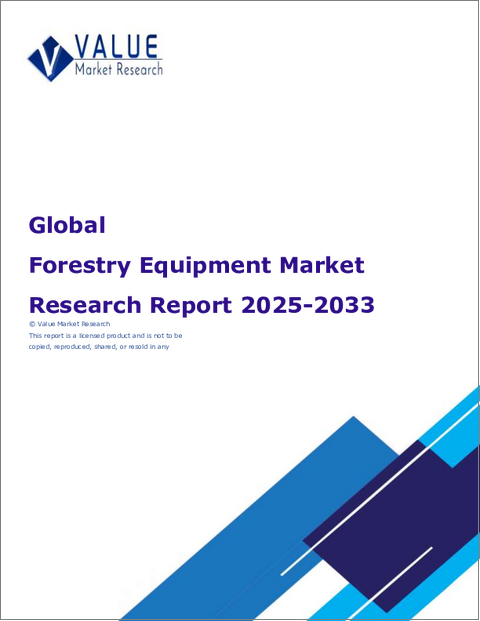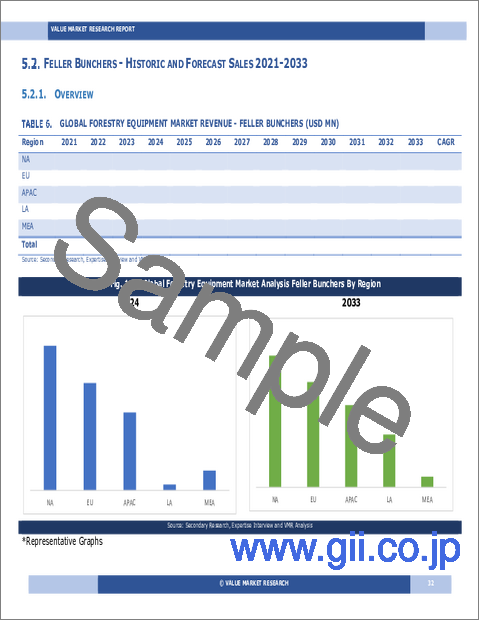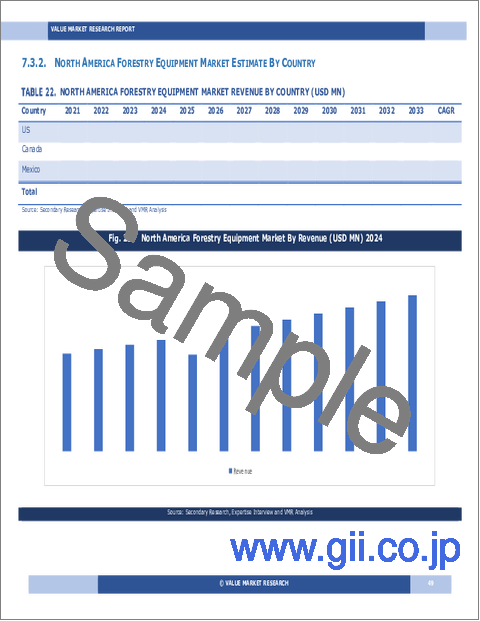|
|
市場調査レポート
商品コード
1721311
林業機械の世界市場調査レポート:産業分析、規模、シェア、成長、動向、2025年から2033年までの予測Global Forestry Equipment Market Research Report- Industry Analysis, Size, Share, Growth, Trends and Forecast 2025 to 2033 |
||||||
カスタマイズ可能
|
|||||||
| 林業機械の世界市場調査レポート:産業分析、規模、シェア、成長、動向、2025年から2033年までの予測 |
|
出版日: 2025年04月01日
発行: Value Market Research
ページ情報: 英文 125 Pages
納期: 即日から翌営業日
|
全表示
- 概要
- 図表
- 目次
世界の林業機械市場規模は、2024年の99億5,000万米ドルから2033年には168億9,000万米ドルに成長し、2026年から2033年の予測期間中に6.06%の堅調な年間平均成長率(CAGR)を示すと予測されます。
林業機械市場は、持続可能な森林管理と木材生産への需要が高まり続けていることから、大きな成長を遂げようとしています。ハーベスター、フォワーダー、チッパーなどの林業機械は、伐採作業の最適化と生産性の向上に重要な役割を果たしています。産業界が持続可能な施業と効率的な資源利用をますます優先するようになるにつれ、先進的な林業機械の採用が急増すると予想されます。自動化、テレマティクス、精密林業などの技術革新が林業機械の能力を高め、近代的な林業作業に不可欠なツールとなっています。
さらに、環境保全と規制遵守が重視されるようになり、生態系への影響を最小限に抑える林業機械の需要が高まっています。政府や団体が伐採作業をめぐる規制を強化するにつれて、持続可能な伐採方法をサポートする機器へのニーズは高まり続けると思われます。この動向は市場の技術革新を促進し、効率性、安全性、環境性能を強化した林業機械の開発につながると予想されます。
さらに、バイオマスエネルギーの台頭と再生可能資源への注目の高まりは、林業機械市場をさらに推進すると予想されます。産業界が持続可能なエネルギー源としてバイオマスを活用しようとするにつれ、バイオマス原料を効率的に処理・管理できる機器への需要が高まります。このような持続可能なエネルギーソリューションへのシフトは、林業機械技術への投資を促進し、同市場のメーカーやサプライヤーに新たな機会をもたらすと思われます。林業機械市場の将来は、多様な用途において生産性、持続可能性、業務効率を高める継続的な進歩が特徴です。
当レポートは、様々な産業や市場に関する包括的かつ実用的な洞察をお客様に提供できるよう、綿密に作成されています。各レポートは、市場情勢を完全に理解するために、いくつかの重要な要素を含んでいます:
市場概要:定義、分類、業界の現状など、市場に関する詳細なイントロダクション。
市場力学:市場成長に影響を与える主な促進要因・抑制要因・機会・課題を詳細に分析します。このセクションでは、技術の進歩、規制の変更、新たな動向などの要因を検証します。
セグメンテーション分析:製品タイプ、用途、エンドユーザー、地域などの基準に基づき、市場を明確なセグメントに内訳。この分析により、各セグメントの業績と将来性を明らかにします。
競合情勢:市場シェア、製品ポートフォリオ、戦略的イニシアティブ、財務実績など、主要市場企業の包括的評価。主要企業が採用する競合力学と主要戦略に関する考察を提供します。
市場予測:過去のデータと現在の市場状況に基づき、一定期間における市場規模と成長動向を予測します。これには、定量的分析と将来の市場軌跡を示すグラフ表示が含まれます。
地域分析:地域ごとの市場パフォーマンスを評価し、主要市場や地域動向を明らかにします。地域の市場力学とビジネスチャンスを理解するのに役立ちます。
新たな動向と機会:現在の市場動向と新たな市場動向、技術革新、潜在的な投資対象分野を特定します。将来の市場開拓と成長見通しに関する洞察を提供します。
目次
第1章 序文
第2章 エグゼクティブサマリー
- 市場のハイライト
- 世界市場スナップショット
第3章 林業機械産業分析
- イントロダクション:市場力学
- 市場促進要因
- 市場抑制要因
- 市場機会
- 業界動向
- ファイブフォース分析
- 市場の魅力分析
第4章 バリューチェーン分析
- バリューチェーン分析
- 原材料分析
- 原材料リスト
- 原材料メーカーリスト
- 主要原材料の価格動向
- 潜在的バイヤーリスト
- マーケティングチャネル
- ダイレクトマーケティング
- インダイレクトマーケティング
- マーケティングチャネル発展動向
第5章 林業機械の世界市場分析:タイプ別
- 概要:タイプ別
- 過去および予測データ分析:タイプ別
- フェラーバンチャー
- ハーベスター
- スキダー
- ローダー
- フォワーダ
- グラップル
- 伐採ヘッド
- ハーベストヘッド
- ヤーダー
- その他
第6章 林業機械の世界市場分析:作業別
- 概要:作業別
- 過去および予測データ分析:作業別
- ディーゼル
- 電気式ハイブリッド
第7章 林業機械の世界市場分析:地域別
- 地域別の展望
- イントロダクション
- 北米の売上分析
- 概要、実績と予測
- 北米:セグメント別
- 北米:国別
- 米国
- カナダ
- メキシコ
- 欧州の売上分析
- 概要、実績と予測
- 欧州:セグメント別
- 欧州:国別
- 英国
- フランス
- ドイツ
- イタリア
- ロシア
- その他欧州
- アジア太平洋地域の売上分析
- 概要、実績と予測
- アジア太平洋地域:セグメント別
- アジア太平洋地域:国別
- 中国
- インド
- 日本
- 韓国
- オーストラリア
- 東南アジア
- その他アジア太平洋地域
- ラテンアメリカの売上分析
- 概要、実績と予測
- ラテンアメリカ:セグメント別
- ラテンアメリカ:国別
- ブラジル
- アルゼンチン
- ペルー
- チリ
- その他ラテンアメリカ
- 中東・アフリカの売上分析
- 概要、実績と予測
- 中東・アフリカ:セグメント別
- 中東・アフリカ:国別
- サウジアラビア
- アラブ首長国連邦
- イスラエル
- 南アフリカ
- その他中東・アフリカ
第8章 林業機械企業の競合情勢
- 林業機械市場の競合
- 提携・協力・協定
- 合併・買収
- 新製品発売
- その他の開発
第9章 企業プロファイル
- 上位企業の市場シェア分析
- 市場集中度
- John Deere
- Komatsu Ltd.
- Barko Hydraulics LLC.
- Tigercat International Inc.
- Caterpillar Inc.
- Rottne Industri AB
- The Volvo Group
- Hitachi Construction Machinery Co. Ltd.
- Doosan Infracore Co. Ltd
- The Husqvarna Group
- Tanguay Machinery
- Bell Equipment Company SA(Pty)Ltd.
- Terex Deutschland GmbH
- Log Max AB
- Stihl Holding AG & Co. KG
- Eco Log Sweden AB
LIST OF TABLES
- Market Snapshot
- Drivers: Impact Analysis
- Restraints: Impact Analysis
- List of Raw Material
- List of Raw Material Manufactures
- Analysis By Type (USD MN)
- Feller Bunchers Market Sales By Geography (USD MN)
- Harvester Market Sales By Geography (USD MN)
- Skidders Market Sales By Geography (USD MN)
- Loaders Market Sales By Geography (USD MN)
- Forwarders Market Sales By Geography (USD MN)
- Grapples Market Sales By Geography (USD MN)
- Felling Heads Market Sales By Geography (USD MN)
- Harvesting Heads Market Sales By Geography (USD MN)
- Yarders Market Sales By Geography (USD MN)
- Other Market Sales By Geography (USD MN)
- Analysis By Operation (USD MN)
- Diesel Market Sales By Geography (USD MN)
- Electrical Hybrid Market Sales By Geography (USD MN)
- Global Forestry Equipment Market Sales By Geography (USD MN)
- North America Market Analysis (USD MN)
- United States Market Analysis (USD MN)
- Canada Market Analysis (USD MN)
- Mexico Market Analysis (USD MN)
- Europe Market Analysis (USD MN)
- Europe Market Estimate By Country (USD MN)
- United Kingdom Market Analysis (USD MN)
- France Market Analysis (USD MN)
- Germany Market Analysis (USD MN)
- Italy Market Analysis (USD MN)
- Russia Market Analysis (USD MN)
- Spain Market Analysis (USD MN)
- Rest of Europe Market Analysis (USD MN)
- Asia Pacific Market Analysis (USD MN)
- China Market Analysis (USD MN)
- Japan Market Analysis (USD MN)
- India Market Analysis (USD MN)
- South Korea Market Analysis (USD MN)
- Australia Market Analysis (USD MN)
- South East Asia Market Analysis (USD MN)
- Rest of Asia Pacific Market Analysis (USD MN)
- Latin America Market Analysis (USD MN)
- Brazil Market Analysis (USD MN)
- Argentina Market Analysis (USD MN)
- Peru Market Analysis (USD MN)
- Chile Market Analysis (USD MN)
- Rest of Latin America Market Analysis (USD MN)
- Middle East & Africa Market Analysis (USD MN)
- Saudi Arabia Market Analysis (USD MN)
- UAE Market Analysis (USD MN)
- Israel Market Analysis (USD MN)
- South Africa Market Analysis (USD MN)
- Rest of Middle East and Africa Market Analysis (USD MN)
- Partnership/Collaboration/Agreement
- Mergers And Acquisition
LIST OF FIGURES
- Research Scope of Forestry Equipment Report
- Market Research Process
- Market Research Methodology
- Global Forestry Equipment Market Size, By Region (USD MN)
- Porters Five Forces Analysis
- Market Attractiveness Analysis By Type
- Market Attractiveness Analysis By Operation
- Market Attractiveness Analysis By Region
- Value Chain Analysis
- Global Market Analysis By Type (USD MN)
- Feller Bunchers Market Sales By Geography (USD MN)
- Harvester Market Sales By Geography (USD MN)
- Skidders Market Sales By Geography (USD MN)
- Loaders Market Sales By Geography (USD MN)
- Forwarders Market Sales By Geography (USD MN)
- Grapples Market Sales By Geography (USD MN)
- Felling Heads Market Sales By Geography (USD MN)
- Harvesting Heads Market Sales By Geography (USD MN)
- Yarders Market Sales By Geography (USD MN)
- Other Market Sales By Geography (USD MN)
- Global Market Analysis By Operation (USD MN)
- Diesel Market Sales By Geography (USD MN)
- Electrical Hybrid Market Sales By Geography (USD MN)
- Global Market Sales (USD MN)
- North America Market Sales (USD MN)
- Europe Market Sales (USD MN)
- Asia Pacific Market Sales (USD MN)
- Latin America Market Sales (USD MN)
- Middle East & Africa Market Sales (USD MN)
- Recent Development in Industry
- Top Company Market Share Analysis
Kindly note that the above listed are the basic tables and figures of the report and are not limited to the TOC.
Global Forestry Equipment Market size is anticipated to grow from USD 9.95 Billion in 2024 to USD 16.89 Billion by 2033, showcasing a robust Compound Annual Growth Rate (CAGR) of 6.06% during the forecast period of 2026 to 2033.
The forestry equipment market is poised for significant growth as the demand for sustainable forest management and timber production continues to rise. Forestry equipment, including harvesters, forwarders, and chippers, plays a crucial role in optimizing logging operations and enhancing productivity. As industries increasingly prioritize sustainable practices and efficient resource utilization, the adoption of advanced forestry equipment is expected to surge. Innovations in technology, such as automation, telematics, and precision forestry, are enhancing the capabilities of forestry equipment, making them essential tools for modern forestry operations.
Moreover, the growing emphasis on environmental conservation and regulatory compliance is driving the demand for forestry equipment that minimizes ecological impact. As governments and organizations implement stricter regulations surrounding logging practices, the need for equipment that supports sustainable harvesting methods will continue to grow. This trend is expected to foster innovation in the market, leading to the development of forestry equipment that offers enhanced efficiency, safety, and environmental performance.
Additionally, the rise of biomass energy and the increasing focus on renewable resources are anticipated to further propel the forestry equipment market. As industries seek to capitalize on biomass as a sustainable energy source, the demand for equipment that can efficiently process and manage biomass materials will increase. This shift towards more sustainable energy solutions will drive investments in forestry equipment technologies, creating new opportunities for manufacturers and suppliers in the market. The future of the forestry equipment market is characterized by continuous advancements that enhance productivity, sustainability, and operational efficiency across diverse applications.
Our reports are meticulously crafted to provide clients with comprehensive and actionable insights into various industries and markets. Each report encompasses several critical components to ensure a thorough understanding of the market landscape:
Market Overview: A detailed introduction to the market, including definitions, classifications, and an overview of the industry's current state.
Market Dynamics: In-depth analysis of key drivers, restraints, opportunities, and challenges influencing market growth. This section examines factors such as technological advancements, regulatory changes, and emerging trends.
Segmentation Analysis: Breakdown of the market into distinct segments based on criteria like product type, application, end-user, and geography. This analysis highlights the performance and potential of each segment.
Competitive Landscape: Comprehensive assessment of major market players, including their market share, product portfolio, strategic initiatives, and financial performance. This section provides insights into the competitive dynamics and key strategies adopted by leading companies.
Market Forecast: Projections of market size and growth trends over a specified period, based on historical data and current market conditions. This includes quantitative analyses and graphical representations to illustrate future market trajectories.
Regional Analysis: Evaluation of market performance across different geographical regions, identifying key markets and regional trends. This helps in understanding regional market dynamics and opportunities.
Emerging Trends and Opportunities: Identification of current and emerging market trends, technological innovations, and potential areas for investment. This section offers insights into future market developments and growth prospects.
SEGMENTATION COVERED IN THE REPORT
By Type
- Feller Bunchers
- Harvester
- Skidders
- Loaders
- Forwarders
- Grapples
- Felling Heads
- Harvesting Heads
- Yarders
- Other
By Operation
- Diesel
- Electrical Hybrid
- COMPANIES PROFILED
- John Deere
- Komatsu Ltd.
- Barko Hydraulics LLC.
- Tigercat International Inc.
- Caterpillar Inc.
- Rottne Industri AB
- The Volvo Group
- Hitachi Construction Machinery Co. Ltd.
- Doosan Infracore Co. Ltd
- The Husqvarna Group
- Tanguay Machinery
- Bell Equipment Company SA (Pty) Ltd.
- Terex Deutschland GmbH
- Log Max AB
- Stihl Holding AG & Co. KG
- Eco Log Sweden AB
- The above list can be customized.
TABLE OF CONTENTS
1. PREFACE
- 1.1. Report Description
- 1.1.1 Objective
- 1.1.2 Target Audience
- 1.1.3 Unique Selling Proposition (USP) & offerings
- 1.2. Research Scope
- 1.3. Research Methodology
- 1.3.1 Market Research Process
- 1.3.2 Market Research Methodology
2. EXECUTIVE SUMMARY
- 2.1. Highlights of Market
- 2.2. Global Market Snapshot
3. FORESTRY EQUIPMENT INDUSTRY ANALYSIS
- 3.1. Introduction - Market Dynamics
- 3.2. Market Drivers
- 3.3. Market Restraints
- 3.4. Opportunities
- 3.5. Industry Trends
- 3.6. Poerter's Five Force Analysis
- 3.7. Market Attractiveness Analysis
- 3.7.1 Market Attractiveness Analysis By Type
- 3.7.2 Market Attractiveness Analysis By Operation
- 3.7.3 Market Attractiveness Analysis By Region
4. VALUE CHAIN ANALYSIS
- 4.1. Value Chain Analysis
- 4.2. Raw Material Analysis
- 4.2.1 List of Raw Materials
- 4.2.2 Raw Material Manufactures List
- 4.2.3 Price Trend of Key Raw Materials
- 4.3. List of Potential Buyers
- 4.4. Marketing Channel
- 4.4.1 Direct Marketing
- 4.4.2 Indirect Marketing
- 4.4.3 Marketing Channel Development Trend
5. GLOBAL FORESTRY EQUIPMENT MARKET ANALYSIS BY TYPE
- 5.1. Overview By Type
- 5.2. Historical and Forecast Data Analysis By Type
- 5.3. Feller Bunchers Historic and Forecast Sales By Regions
- 5.4. Harvester Historic and Forecast Sales By Regions
- 5.5. Skidders Historic and Forecast Sales By Regions
- 5.6. Loaders Historic and Forecast Sales By Regions
- 5.7. Forwarders Historic and Forecast Sales By Regions
- 5.8. Grapples Historic and Forecast Sales By Regions
- 5.9. Felling Heads Historic and Forecast Sales By Regions
- 5.10. Harvesting Heads Historic and Forecast Sales By Regions
- 5.11. Yarders Historic and Forecast Sales By Regions
- 5.12. Other Historic and Forecast Sales By Regions
6. GLOBAL FORESTRY EQUIPMENT MARKET ANALYSIS BY OPERATION
- 6.1. Overview By Operation
- 6.2. Historical and Forecast Data Analysis By Operation
- 6.3. Diesel Historic and Forecast Sales By Regions
- 6.4. Electrical Hybrid Historic and Forecast Sales By Regions
7. GLOBAL FORESTRY EQUIPMENT MARKET ANALYSIS BY GEOGRAPHY
- 7.1. Regional Outlook
- 7.2. Introduction
- 7.3. North America Sales Analysis
- 7.3.1 Overview, Historic and Forecast Data Sales Analysis
- 7.3.2 North America By Segment Sales Analysis
- 7.3.3 North America By Country Sales Analysis
- 7.3.4 United States Sales Analysis
- 7.3.5 Canada Sales Analysis
- 7.3.6 Mexico Sales Analysis
- 7.4. Europe Sales Analysis
- 7.4.1 Overview, Historic and Forecast Data Sales Analysis
- 7.4.2 Europe By Segment Sales Analysis
- 7.4.3 Europe By Country Sales Analysis
- 7.4.4 United Kingdom Sales Analysis
- 7.4.5 France Sales Analysis
- 7.4.6 Germany Sales Analysis
- 7.4.7 Italy Sales Analysis
- 7.4.8 Russia Sales Analysis
- 7.4.9 Rest Of Europe Sales Analysis
- 7.5. Asia Pacific Sales Analysis
- 7.5.1 Overview, Historic and Forecast Data Sales Analysis
- 7.5.2 Asia Pacific By Segment Sales Analysis
- 7.5.3 Asia Pacific By Country Sales Analysis
- 7.5.4 China Sales Analysis
- 7.5.5 India Sales Analysis
- 7.5.6 Japan Sales Analysis
- 7.5.7 South Korea Sales Analysis
- 7.5.8 Australia Sales Analysis
- 7.5.9 South East Asia Sales Analysis
- 7.5.10 Rest Of Asia Pacific Sales Analysis
- 7.6. Latin America Sales Analysis
- 7.6.1 Overview, Historic and Forecast Data Sales Analysis
- 7.6.2 Latin America By Segment Sales Analysis
- 7.6.3 Latin America By Country Sales Analysis
- 7.6.4 Brazil Sales Analysis
- 7.6.5 Argentina Sales Analysis
- 7.6.6 Peru Sales Analysis
- 7.6.7 Chile Sales Analysis
- 7.6.8 Rest of Latin America Sales Analysis
- 7.7. Middle East & Africa Sales Analysis
- 7.7.1 Overview, Historic and Forecast Data Sales Analysis
- 7.7.2 Middle East & Africa By Segment Sales Analysis
- 7.7.3 Middle East & Africa By Country Sales Analysis
- 7.7.4 Saudi Arabia Sales Analysis
- 7.7.5 UAE Sales Analysis
- 7.7.6 Israel Sales Analysis
- 7.7.7 South Africa Sales Analysis
- 7.7.8 Rest Of Middle East And Africa Sales Analysis
8. COMPETITIVE LANDSCAPE OF THE FORESTRY EQUIPMENT COMPANIES
- 8.1. Forestry Equipment Market Competition
- 8.2. Partnership/Collaboration/Agreement
- 8.3. Merger And Acquisitions
- 8.4. New Product Launch
- 8.5. Other Developments
9. COMPANY PROFILES OF FORESTRY EQUIPMENT INDUSTRY
- 9.1. Top Companies Market Share Analysis
- 9.2. Market Concentration Rate
- 9.3. John Deere
- 9.3.1 Company Overview
- 9.3.2 Company Revenue
- 9.3.3 Products
- 9.3.4 Recent Developments
- 9.4. Komatsu Ltd.
- 9.4.1 Company Overview
- 9.4.2 Company Revenue
- 9.4.3 Products
- 9.4.4 Recent Developments
- 9.5. Barko Hydraulics LLC.
- 9.5.1 Company Overview
- 9.5.2 Company Revenue
- 9.5.3 Products
- 9.5.4 Recent Developments
- 9.6. Tigercat International Inc.
- 9.6.1 Company Overview
- 9.6.2 Company Revenue
- 9.6.3 Products
- 9.6.4 Recent Developments
- 9.7. Caterpillar Inc.
- 9.7.1 Company Overview
- 9.7.2 Company Revenue
- 9.7.3 Products
- 9.7.4 Recent Developments
- 9.8. Rottne Industri AB
- 9.8.1 Company Overview
- 9.8.2 Company Revenue
- 9.8.3 Products
- 9.8.4 Recent Developments
- 9.9. The Volvo Group
- 9.9.1 Company Overview
- 9.9.2 Company Revenue
- 9.9.3 Products
- 9.9.4 Recent Developments
- 9.10. Hitachi Construction Machinery Co. Ltd.
- 9.10.1 Company Overview
- 9.10.2 Company Revenue
- 9.10.3 Products
- 9.10.4 Recent Developments
- 9.11. Doosan Infracore Co. Ltd
- 9.11.1 Company Overview
- 9.11.2 Company Revenue
- 9.11.3 Products
- 9.11.4 Recent Developments
- 9.12. The Husqvarna Group
- 9.12.1 Company Overview
- 9.12.2 Company Revenue
- 9.12.3 Products
- 9.12.4 Recent Developments
- 9.13. Tanguay Machinery
- 9.13.1 Company Overview
- 9.13.2 Company Revenue
- 9.13.3 Products
- 9.13.4 Recent Developments
- 9.14. Bell Equipment Company SA (Pty) Ltd.
- 9.14.1 Company Overview
- 9.14.2 Company Revenue
- 9.14.3 Products
- 9.14.4 Recent Developments
- 9.15. Terex Deutschland GmbH
- 9.15.1 Company Overview
- 9.15.2 Company Revenue
- 9.15.3 Products
- 9.15.4 Recent Developments
- 9.16. Log Max AB
- 9.16.1 Company Overview
- 9.16.2 Company Revenue
- 9.16.3 Products
- 9.16.4 Recent Developments
- 9.17. Stihl Holding AG & Co. KG
- 9.17.1 Company Overview
- 9.17.2 Company Revenue
- 9.17.3 Products
- 9.17.4 Recent Developments
- 9.18. Eco Log Sweden AB
- 9.18.1 Company Overview
- 9.18.2 Company Revenue
- 9.18.3 Products
- 9.18.4 Recent Developments





